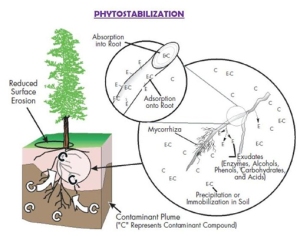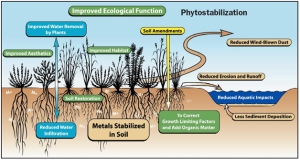Environmental Biotechnology
The use of genetic engineered organisms for pollution abatement
Tag Archives: disadvantages of phytostabilization
Phytostabilization
Posted by on January 31, 2011
In phytostabilization, soil contaminants are immobilized through absorption by roots, adsorption onto root surface and precipitation within the area of plant roots. As such, the plant and plant roots are employed to prevent the spread or migration of contaminants through wind and water erosion, soil dispersion and leaching. Phytostabilization influences the contaminant’s mobility in several ways:
• The amendments directly change the soil condition that influences the mobility of metal contaminants (acidic or alkaline conditions, organic matter, oxygen levels).
For example, a soil’s pH have an effect on the retention and mobility of metals in soil columns. The pH is a controlling factor in precipitation-solubilization reactions. This affects the solubility of nutrient elements and toxic elements, and it affects the ion exchange that binds nutrients and toxicants to soil particles.
• Enzymes and proteins secreted by plant roots into adjacent soil results in immobilization and precipitation of the contaminants in soil or on root surface.
• Contaminant accumulated in plant tissue becomes insoluble and or immobilized after absorption through plant roots.
• When the surface of the soil is vegetated, the vegetation serves as a barrier for physical contact and to minimize erosion by wind and water.
Advantages
- Phytostabilization does not produce secondary waste that needs treatment.
- Compared with other remediation technologies, such as excavation, materials that were used and handled are lesser, and costs are typically lower.
- Usually the technology enhances the soil fertility. It may combine treatment with ecosystem restoration
- Water removal is improved with more plants that reduce water infiltration. With that, soluble contaminants are unable to leach into soil and contaminate ground water.
- Improved Aesthetic
- Vegetation offers a protective covering to help reduce the impact of wind, over watering and rainfall; they will also stabilize the properties of soil and thus, prevent soil erosion. As a result, impact on aquatic life will be greatly reduced due to lesser sediment deposition
Disadvantages
- The contaminants are left in place, so the site must be monitored continuously to maintain the stabilizing conditions.
- If the contaminant concentrations increase to a high level, toxic effects may prevent plants from growing
- If soil additives are used, there may be a need to reapply them over and over again in order maintain the immobilization effectiveness of contaminants.


Recent Comments